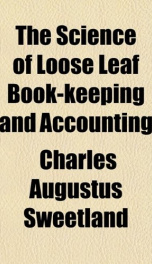the science of loose leaf book keeping and accounting

Purchase of this book includes free trial access to www.million-books.com where you can read more than a million books for free. This is an OCR edition with typos. Excerpt from book: X f) be somewhat wider than the ordinary ledger to make room for additional spaces required. Some book-keepers and business houses still cling to the old idea of having a "Double Double" ruling thinking that it will save space and render the book more useful, but when you take into consideration the number of small accounts where the largest portion of the page is not used up for a long time, it does not seem that there is any real necessity for using the "Double Double" in Loose Leaf Books. Of course the public have been for many years accustomed to the sewed books wherein, in order to have sufficient amount of space without transferring frequently, the "Double Double" was a great necessity, in-as-much as it enabled bookkeepers to have a much larger number of accounts in one ledger, than could be done with the single ruling. The fact however that the expansion of accounts is limitless under the Loose Leaf plan renders the necessity for "Double Double" in ruling absolutely nil. Of. course various columns may be introduced made necessary by requirements of any special line of business, for instance, "the terms," "the due date," "requisition number," "salesman" or any other explanatory column required. Necessities of the business can thus be closely followed in the ruling of loose sheets and by bringing them within the columns arranged thus, reduces to a very large extent the amount of labor required in keeping an accurate account. On most of the Loose Leaf sheets chapter{Section 4.r the heading of the different columns are printed in and the name of the firm at the head of each sheet, this is a special advantage where columns are introduced for a definite use, outside of the regular ledger column. Of course where the regular ruling is made, it is not absolutely ne...
Info about the book
Series:
Unknown
ISBN:
1429253029
Rating:
4.5/5 (3)Your rating:
0/5
Languge:
English
Users who have this book
Users who want this book
What readers are saying
What do you think? Write your own comment on this book!
write a commentif you like the science of loose leaf book keeping and accounting try:
Other books by this author
Do you want to read a book that interests you? It’s EASY!
Create an account and send a request for reading to other users on the Webpage of the book!

